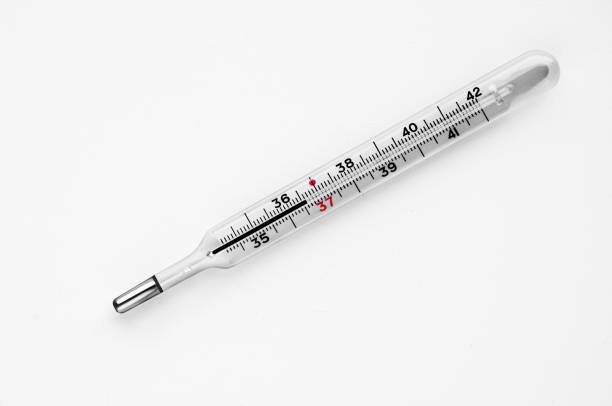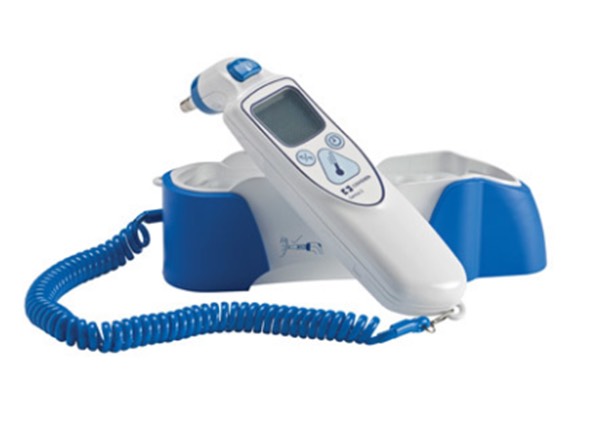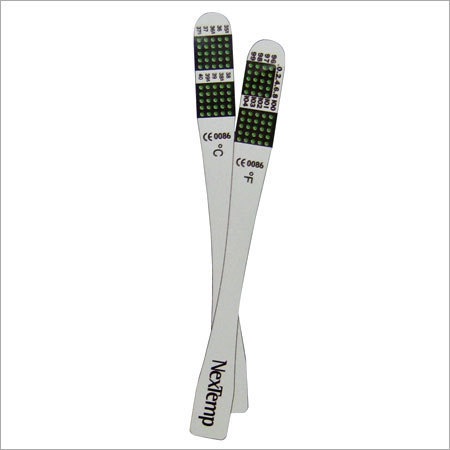Thermometer
Subject: Fundamentals of Nursing

Overview
Thermometer
A thermometer is a device for measuring temperature. A scaled tube-like device called a clinical thermometer is used to gauge body temperature. Either Celsius or Fahrenheit can be used for calibration.
Types of Thermometer
Mercury-in-glass Thermometers:
Historically, thermometers made of mercury in glass were used to measure body temperatures. A glass tube with a scale at one end and a mercury-filled bulb at the other makes up the mercury-in-glass thermometer. The mercury in the light bulb expands when it is exposed to heat, moving it up a point on the scale. At this moment, the mercury begins to stabilize and won't drop unless the thermometer is violently disturbed. The oral, stubby, and rectal thermometers are three varieties of glass thermometers. The thin, glass tip of the oral thermometer provides maximum exposure to the mouth mucosa. The tip of an oral thermometer is often blue.The axillary temperature can also be measured with the oral thermometer. The blunt or tapered end of the rectal glass thermometer is intended to reduce risk of injury to the rectal mucosa during insertion. A red tip helps you to identify it most often. The oral thermometer is thinner and shorter than the stubby thermometer. Any place may use it to measure temperature. Glass thermometers provide several benefits, including affordability, accessibility, and dependability. The amount of time a glass thermometer has been stored before being used affects its accuracy. These thermometers should typically not be kept for longer than six months.
Parts of a Mercury Thermometer
- The Bulbs: It contains mercury and mercury rises in a stem. There is graduated scale on the stem, which represents the degree of temperature. The bulbs are of different size and shapes. The oral thermometers are with long and slender be bulbs. The rectal thermometers are with short and fat bulbs.

- The Stem: It has a curved surface which magnifies the lines and figures on the scale. The o stem has flattened back with a sharp ridge that makes easier to read the scale. The flat surface prevents rolling.
Digital Thermometers:
Regular digital thermometers use electronic heat sensors to record body temperature. It is a small hand-held device with a "window" showing temperature in numbers. There are many kinds of digital thermometers. Most digital thermometers are easy to use and measure body temperature in less than a minute. These thermometers can be used in the rectum, mouth or armpit. Separate non-breakable probes are available for oral and rectal use. We can get the fastest and most accurate results with a digital thermometer. They are available in many shapes and sizes. Carefully read the instructions before using your digital thermometer.
TympanicMmembrane Thermometer:

The tympanic membrane thermometer is a portable hand-held device resembling an otoscope that recharges using a battery pack. It records temperature through a sensor probe that is placed in the ear canal to detect infrared radiation from the ear drum. Within 2 to 5 seconds of placement in the auditory canal, a reading appears on the display unit. The tympanic membrane thermometer is especially appropriate for infants over 2 months or a very young child who may have difficulty remaining still while temperature is recorded using other methods. The tympanic membrane thermometer is often preferred in emergency departments or other areas where assessments must be made quickly. These should not be used on people who have ear drainage or scarred tympanic membranes.
Disposable Paper Thermometer:

Disposable single-use thermometers are thin strips of plastic with a temperature sensor at one end. The sensor consists of a matrix of dot like indications. That obtains chemicals that melt and change color at different temperature. They are used for oral or axillary temperatures, particularly with children. They are inserted the same way as an oral or axillary thermometer and used only once. The thermometer is removed after 60 seconds and read after waiting about 10 seconds to ensure the temperature reading has stabilized. Another form of disposable thermometer is a temperature sensitive patch or tape. Applied to the forehead or abdomen, the patch changes color at different temperatures. These thermometers are also useful for screening clients. Disposable thermometers are not appropriate for monitoring temperature therapies.
Forehead Thermometers:
This is also used to measure temperature, but they may not be as reliable as the digital thermometers. Forehead thermometers are placed on the temporal artery of the forehead and will read the infrared heat that comes off of the head.
Pacifier Thermometer:
When an infant is younger than three months you cannot use a pacifier thermometer to take his temperature. The baby must be still for a few minutes with the pacifier in their mouth. It is generally very hard for babies to stay very still and this may make the reading on the thermometer wrong.
Common Sites for Taking Temperature
There are several sites for measuring body temperature. The core temperature of the pulmonary artery, esophagus and urinary bladder are used in intensive care settings.
The commonly used sites of taking body temperature are:
Orally: Temperature can be taken by mouth using either the classic glass thermometer, or the more modern digital thermometers that use an electronic probe to measure body temperature.
Rectally: Temperatures taken rectally (using a glass or digital thermometer) tend to be 0.5 to 0.7° F higher than when taken by mouth.
Axillary: Temperatures can be taken under the arm using a glass or digital thermometer. Temperatures taken by this route tend to be 0.3 to 0.4 degrees F lower than those temperatures taken by mouth.
By Ear: A special thermometer can quickly measure the temperature of the ear drum, which reflects the body's core temperature (the temperature of the internal organs).
By Ekin: A special thermometer can quickly measure the temperature of the skin on the forehead.
Variation of Normal Temperature at Different Sites
| Sites | Average normal body temperature |
| Oral | 37°C (98.6°f) |
| Rectual | 37.5°C (99.6°5) |
| Axillary or groin | 36.4°C (97.6°) |
Scales of Thermometer
Centigrade/Celsius: Boiling point 100 degree and freezing point 0 degree (water)
Fahrenheit: Boiling point 212 degree Fahrenheit and freezing point 32 degree Fahrenheit.
Conversion of Temperature C to F and Vice Versa
Sometimes the conversion of the temperature from centigrade to Fahrenheit or vice versa may be necessary.
To convert Fahrenheit to Celsius, subtract 32 from the Fahrenheit reading and multiply the result by 5/9 or
C=(F-32) x 5/9
To convert Celsius to Fahrenheit, multiply the centigrade reading by 9/5 and add 32 to the product.
Or F= (9/5 xC) + 32
Principle of Measuring Body Temperature
- Explain the patient, any unfamiliar treatment procedure makes the patient anxious and tense.
- The reliability of a temperature value depends on choosing the correct equipment, selecting the most appropriate site and using the correct placement of the thermometer and must leave it in place for the appropriate length of time.
- The same site should be used when repeated measurements are necessary.
- The thermometers should be disinfected in a proper disinfectant to prevent cross infection.
- Assess for signs and symptoms of temperature alterations and for factors that influence wilbody temperature.
- Choose the safest and most accurate site for the client.
- Never leave the patient alone with a thermometer in position.
- Wiping from an area where there are less number of organisms to an area where there is a large number of organism present which minimizes the spread of infection. Before taking the temperature, wipe the thermometer from the bulb to the stem and after taking the temperature, wipe the thermometer from the stem to the bulb.
- Never handle thermometer by bulb as it may be easily contaminated or broken.
- Lubricate the bulb of rectal thermometer before placing the thermometer in the rectum to reduce friction, facilitate easy insertion and prevent injury to sphincter muscle.
- Keep oral and rectal thermometer in separate container duly marked.
- Use separate thermometers for each patient to prevent spread of infection.
- Read the thermometer at the eye level and against light.
Purpose of Measuring Body Temperature
- To assess the general health status of patient.
- To evaluate patient's recovery from illness.
- To obtain baseline temperature data for comparing future measurements.
- To assess for any alteration in health status.
- To evaluate temperature response to therapies.
- To monitor fluctuations in temperature e.g. for patient during the post-operative period.
- To monitor sign of reaction after certain medication or intravenous transfusion.
Articles for Taking Vital Signs
- A clean tray containing:
- Thermometer in a container.
- Cotton swab.
- Sprit in spray bottle/a bottle with disinfectant solution.
- Kidney tray/paper bag.
- Graphic chart/paper.
- Pen.
- BP instrument.
- Lubricant in case of rectal method.
- Watch.
- Screen if needed.
Things to remember
© 2021 Saralmind. All Rights Reserved.

 Login with google
Login with google